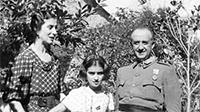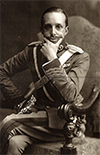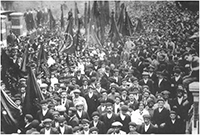Francisco Franco: Spanish General, Dictator
Part 1: Meteoric Rise Francisco Franco was a general who won the Spanish Civil War and served as his country's dictator for more than three decades in the 20th Century. 
He was born Francisco Franco Bahamonde on Dec. 4, 1892, in El Ferrol, in the Spanish northwest area of Galicia. His family had a long tradition in the Navy; his brother Nicolás went on to be come a naval officer, and his brother Ramón went on to be a well-known airplane pilot. Francisco's learning from the training of a Catholic priest gave way, when he was 12, to a stint at a naval secondary school and then, because Spain had capped its admissions to the navy, the infantry academy, from which he graduated when he was 17. He put up his hand to help control an uprising in Morocco, one of Spain's few remaining territories, in 1912 and stayed there for the next 14 years, fighting in the Rif War and serving as second-in-command and then commander of the Tercio de Extranjeros (Spanish Foreign Legion). Franco sustained a serious abdomen injury in a battle during his time there. 
In 1923, he married Carmen Polo y Martínez Valdés. They had a daughter, María del Carmen, in 1926. Franco, who had risen through the ranks, became the youngest general in all of Europe when he achieved that rank in 1926. His next assignment was as head of the General Military Academy, in Zaragoza. 
Spain at the time was under the dictatorship of General Miguel Primo de Rivera, who had the permission of King Alfonso XIII (left). Public opinion of the dictatorship and the king's support for it waned, especially when Rivera proved unable to reverse the downward spiral of the national economy and mood in the wake of the Great Depression. Alfonso XIII, too, became highly unpopular and, after a disastrous showing in the 1931 elections, agreed to leave the country, in favor of the founding of the Second Spanish Republic.  The new government sidelined many military officers, including Franco, shutting down his military academy and assigning him to an out-of-the-way post near where he grew up. He earned the trust of the government again when a right-wing coalition won the elections in 1933. Franco was at the head of a group of troops deployed by the government to suppress an uprising of miners in the northern Asturias region in 1934. Thousands protested against the government, turning violent in their antipathy, and the army turned violent as well, killing thousands and imprisoning many more. As far as the government was concerned, Franco had done his job and so he earned the designation of army chief of staff, in 1935. Spain at this time was awash in political upheaval. Many people wanted to return to the kind of government that the Republic had fostered and styled themselves Republicans. Others, like Franco and many in the army and in the Catholic Church, enjoyed the kind of conservative government then in power. The next elections, in 1936, resulted in a victory for the Republicans in the form of a coalition called the Popular Front. Suspicious that this new government would take away rights and privileges and also fearful of a takeover by Communist forces, Franco joined other military commanders and powerful nobles in plotting to overthrow the government. The new prime minister and later president, Manuel Azaña, oversaw another shuffle of military personnel, in particular sending Franco to a post entirely far away, to the Balearic Islands. He did as he was told, grudgingly. Next page > Victory and Devastation > Page 1, 2, 3 |
|
Social Studies for Kids
copyright 2002–2025
David White




